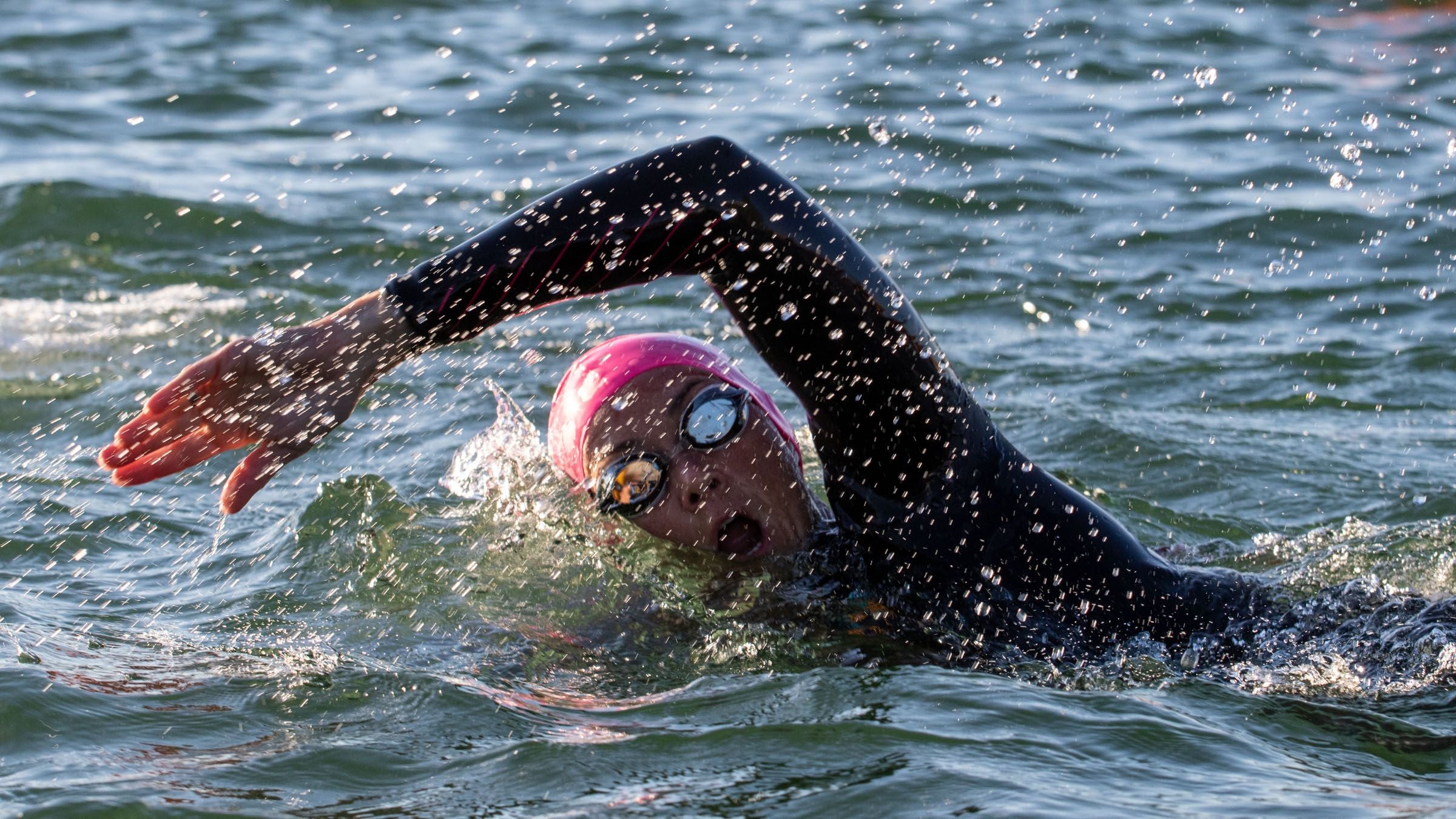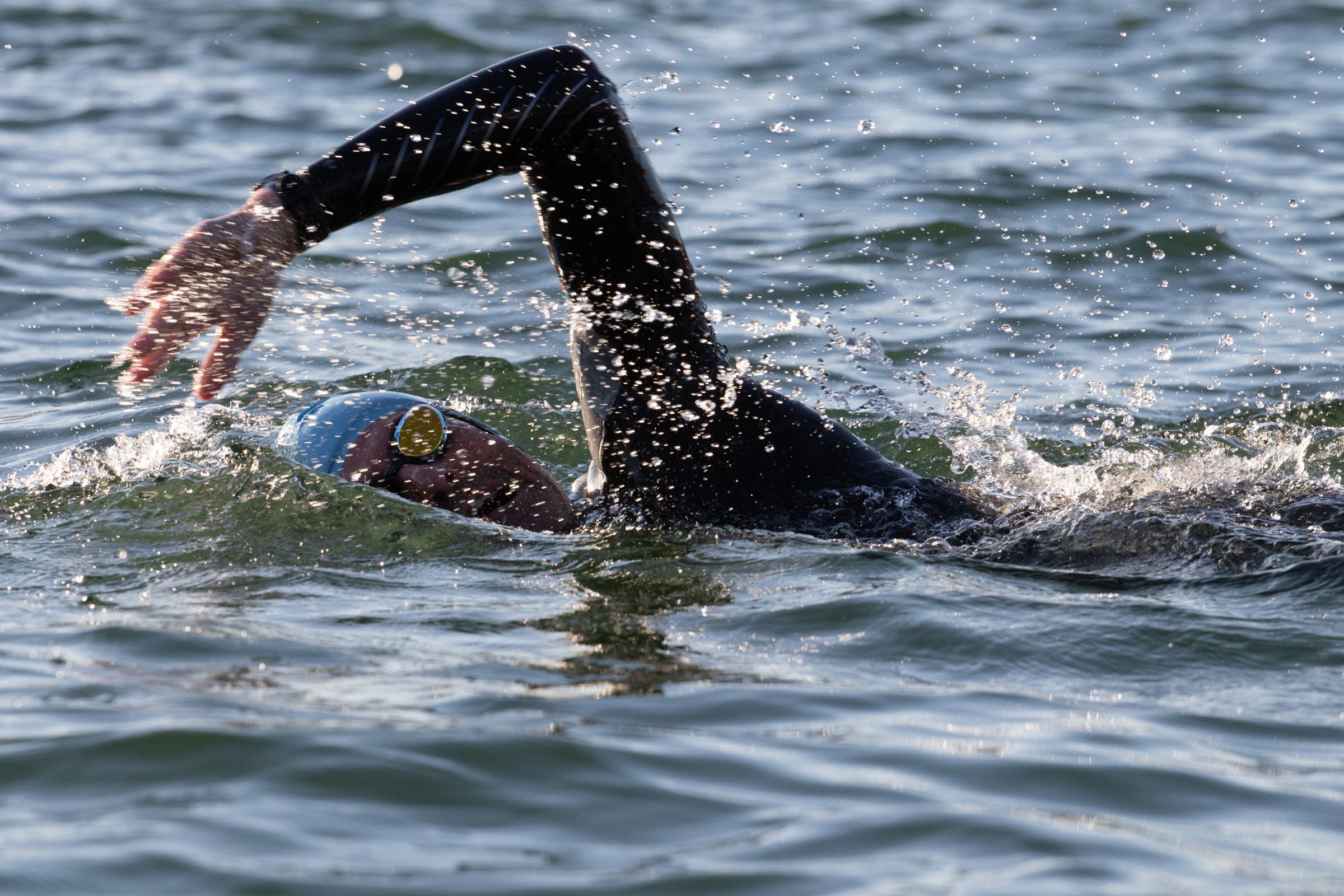Why (And How) To Learn To Bilateral Breathe

(Photo: Brad Kaminski/Triathlete)
Which of the following scenarios have you ever found yourself in during a triathlon?
- Waking up on race morning and checking the weather by peering out the hotel window. Howling and gusting winds greet you with the rising sun. The open water that you splashed around in the day before is now a frothy mess of white water.
- Standing on the beach before a race, you notice that the water isn’t exactly flat like the pool. Instead, there are beautiful sets of four- to five-foot breakers crashing into shore. The race course is about to take you 100 meters out, then along the shore line before leading you back through the waves to dry land.
- Settling into your pace and getting into a grove in the middle of the swim leg of a race. You find some clear water and space to stretch out and find a rhythm. Suddenly, another racer decides that your swim pace and sighting line is perfect, so they just come on over and join you. Right next to you-stroke for stroke, yard for yard.
If you ever had a basic introduction to swimming or taken Swimming 101 (some colleges actually offer this), you know the reasons why bilateral breathing is important. Breathing on both sides of your body while you are swimming creates smooth, even strokes. You get a better balance in the water by alternating your breathing and you develop uniform muscles.
Breathing to both sides of your body becomes even more important when you move from the pool to the open water. Let’s look at the race-scenarios above: waves, wind and other competitors. Being comfortable with bilateral breathing can make you a much calmer athlete in each of these scenarios. Imagine that the swim course puts the shoreline on your right side. If you can breathe to the right, you’ll always have the shore in sight. Or perhaps a competitor starts swimming directly on your right side and sends a giant splash at your face with each of their strokes. If you have practiced bilateral breathing in training, you can just turn you head the other way and forget that she’s there. Finally, there is the element of wind. I have swam multi-loop courses where the wind came from all four directions. Sometimes it seems like you get smacked in the head with rough chop at every buoy turnaround. As long as I remember to breathe away from the chop, I avoid getting smacked in the face and swallowing a gallon of saltwater.
These are just some of the scenarios I might describe to a new swimmer, or an old and stubborn one, to encourage them to practice breathing on their “weak” side.
RELATED: Now is the Time to Correct Your Biggest Swim Mistakes

How To Learn To Bilateral Breathe
I am aware that giving someone a reason to do something doesn’t mean that she’ll actually do it-especially when it comes to bilateral breathing. Why? Because breathing to your non-dominant side feels awkward and uncomfortable at first. Here are a few of my favorite tips for getting past that uncomfortable hump:
First, you should try to increase flexibility in your neck and shoulders. One side of your neck is always tighter (usually as a result of your preferred sleeping position), so stretching before you get into the pool is a simple solution to a seemingly complex problem.
Second, I suggest starting the breath earlier in your stroke cycle. If a swimmer feels she can’t get a full breath of air on her weak side, it’s likely because she is starting to turn her head too late. Your head should begin to rotate as soon as you start to extend the opposite hand forward. But remember: Never lift your head forward to breathe. Your head should rotate directly to your side as you roll your hips in the same direction.
Finally, pay attention to the underwater arm pull during a breath to the weak side. Most swimmers struggling with bilateral breathing will try to pull with a straight arm or will drop their elbow after the catch. If this is happens while taking a breath, it causes the head and torso to sink in the water. This can be the difference between sucking in some quality O2 or some not-so-fun H2O. The solution is to work on proper arm position through the entire pull with lots of high-elbow catch drills during practice.
RELATED: The Four Pillars Of The Freestyle Swim Stroke
Bilateral breathing can be the difference between an enjoyable day at the beach or a life-saving rescue (maybe that’s a bit of a stretch, but you get the point). All it takes is practice at the pool, or a calm day in the open water, to become comfortable breathing to both sides of your body. Your stroke will thank you for becoming more even and fluid. Your lungs will thank you for not trying to breathe in liquid. The lifeguards will thank you for not making them take a break from tanning to save your life. Most importantly, your competitors will hate you for being calmer and faster in the water!
RELATED: How to Breathe When Swimming